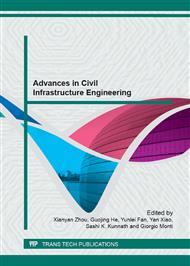p.1038
p.1042
p.1046
p.1051
p.1056
p.1060
p.1069
p.1073
p.1077
Remaining Pre-Stress Identification of Diseased Pre-Stressed Concrete Bridges Based on Neural Network
Abstract:
According to experimental record of bridges in use, more and more damage bridges have appeared, and the most common and severe defect is the bridge damage and cracking problem, which has seriously affected the normal usage of bridges. Analyzing the disease cause of defective bridges more effectively and deeply, in order to optimize the design and construction of bridges becomes the urgent problem in the engineering field. The study is based on the design, construction data and experimental record of the bridge.A non-linear mapping function from multiple input data (the deck elevation of each element in destructing) to multiple output data(the change of pre-stress) is constructed within BP neural networks. Based on the theory of continuous function, the convergence is disadvantageous between 0 and 1. The study shows the expected output data between 0.05 and 0.95 are better for convergence. According to the real data of bridge floor line change in process of destruction, the released pre-stresses are recognized, and the real pre-stresses in existence are calculated by scheme of cable design. The study not only offers reliable scientific basis for analyzing the disease cause in the bridges, but also is helpful to design of the bridges having same structural style.
Info:
Periodical:
Pages:
1056-1059
Citation:
Online since:
January 2013
Authors:
Keywords:
Price:
Сopyright:
© 2013 Trans Tech Publications Ltd. All Rights Reserved
Share:
Citation:


